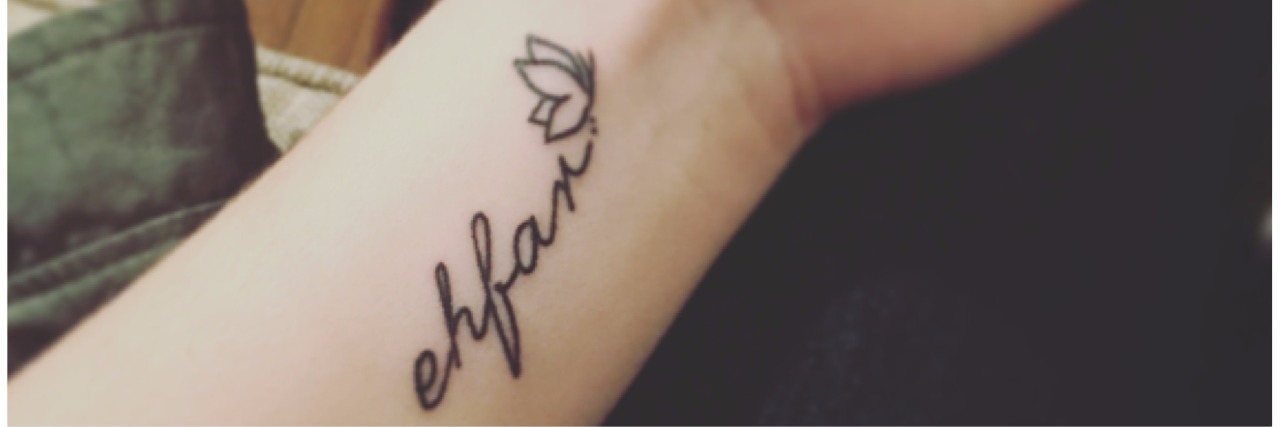I gripped the leather armrest on the chair when Raymond approached me with the needle. “I’m just going to show you what a dot feels like,” he said. I looked in the opposite direction and felt a pinch similar to the way a shot feels. One dot was completed. “Now, I’m going to show you what a line feels like.” The needle punctured my skin over 100 times in only two seconds. To distract myself, Raymond suggested explaining the meaning of my tattoo. “Think of me as your therapist.” The needle buzzed as it broke my skin over and over, and Drake played in the background, but I became enthralled in my own story.
I walked into Carmelo’s Ink City, located in the Lakefront neighborhood of Syracuse surrounded by industrial buildings and houses built in the 1920s to 1930s. Cement blocks and a gray concrete structure held the building together and stereotypical red “tattoo” and “piercing” signs glowed from the windows. I hoped my 2-month-old nose piercing would prove my bravery and readiness for the next step in my self-proclaimed rebellious phase: a tattoo. I didn’t shed a single tear when a 6-inch needle impaled my nose and invaded my nostril. I believed I could bare the pain of having five letters etched into my skin. After all, I found my inner rebel.
Growing up, I never rebelled. I never hated my parents. I never lied. I stayed out past my curfew one time. After being grounded, I never came home past 11:30 p.m. during my junior year, again. I followed all of the junior operator license rules, except for one time when my mom gave me permission to drive my friends so they wouldn’t have to walk to the movie theater in the dark. Before I turned 21 years old, I drank seven sips of beer and downed three shots of alcohol. I never got drunk.
When I walked into the parlor, a two-liter bottle of Purrell — cleanliness concerned me the most — an over-sanitized hospital smell, and a 5-foot, 2-inch artist, Raymond, greeted me. His nose and face piercings sparkled, and a tattoo of a bunny crept up his neck out of his gray T-shirt. He led me into his room, which featured bright oil paintings of his family, the ocean, and a portrait of himself modeling next to a cat. It resembled an art store with the colored inks displayed in rows and tools neatly organized into small drawers.
My palms sweat. My armpits sweat. My butt sweat. I wrestled with the idea of leaving, but my friends accompanied me to document my rebellion on Snapchat. I possessed too much pride to disappoint their Snapchat friends. Raymond suggested listening to Drake’s new album to calm my nerves. I liked to relax with Jack Johnson’s “Banana Pancakes,” but Raymond knew best. Drake sang, “Baby, I like your style,” as Raymond explained the tattoo process and told me to think of him as my therapist.
I told Raymond the most difficult question that people asked me growing up was “How many siblings do you have?” Was the answer one or two sisters? Do I count my older sister whom I never met? My big sister, Elyse, was born with a form of centronuclear myopathy, a rare disease that less than 50 people in the United States have been diagnosed with. Her spine formed a giant “S” shape and her bones were as fragile as styrofoam cups. She wore a full body cast, bright green of course, to look like a Teenage Mutant Ninja Turtle, one of her favorite television shows. She died when she was 3 years old. The night before her death, my mom read her “The Very Hungry Caterpillar.” She told Elyse she was going to turn into a beautiful butterfly.
A year after her death, my mom gave birth to me. I can’t remember a time when I didn’t know my older sister died. When I was 5 years old, I stole a framed picture of her from my living room and carried it to my bedroom so I could cry to her about how I missed her. I often sat and played family videos, mesmerized by this little girl with pale skin and bright green eyes who I longed to have sitting next to me when I watched Barney. Instead, I felt alone, desperate to learn more about Elyse through home videos.
On January 18, 2013, my big sister would have turned 22 years old. My mom yelled to me, “Michaela, come downstairs right now.” My parents were looking through our hope chest, where we keep Elyse’s belongings. My mom handed me an envelope. A pre-school classmate had scribbled Elyse’s name on it in crayon, and tucked a get-well card in it. The class decorated the envelopes in return address mailing stickers. The addresses on the stickers listed places in Syracuse, New York. My family lived in Massachusetts and lacked a connection to New York.
Earlier that year, I applied early decision to Syracuse University. A few days before my sister’s birthday, I received my acceptance and financial aid package. I cried. I received a small scholarship, and I didn’t know how I was going to pay off my debt. My mom and I looked at each other and at the envelope, and she said, “Elyse is giving you a sign that you were meant to go to Syracuse University.”
Back at the tattoo parlor, I finished telling the story of my tattoo, and Raymond said, “Look down.” The letters “EHFAR,” which stood for “everything happens for a reason,” were etched into my skin with a butterfly rising from the letters. I sat down in my car to drive away, ending my rebel phase. Since I can’t lie or hide things from my parents, I prepared my speech to tell them about the end of the phase.

We want to hear your story. Become a Mighty contributor here.

